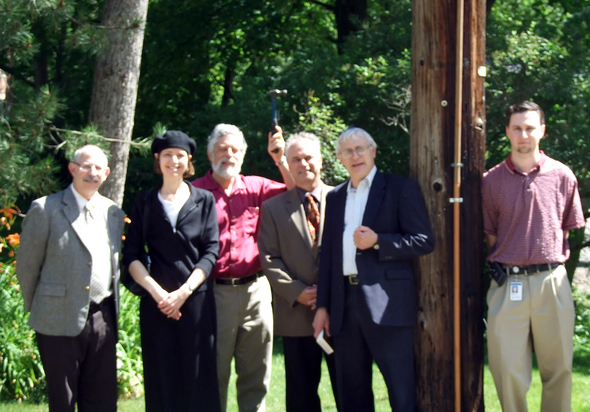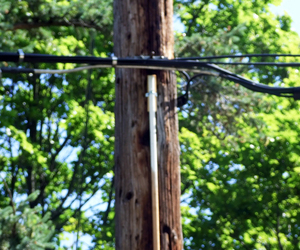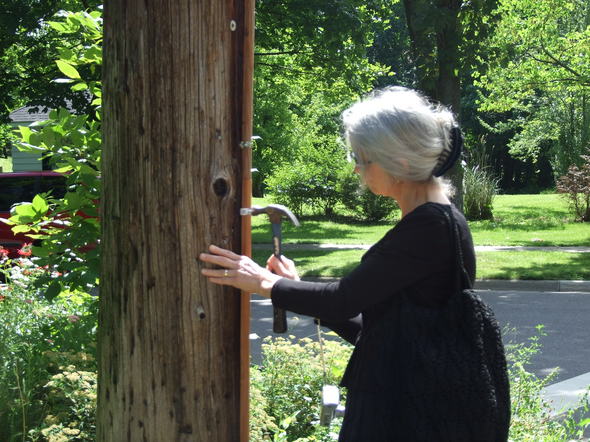Jewish community celebrates completion of ‘eruv’ border for Sabbath observances

A small group gathers to commemorate completion of the eruv for the Ann Arbor Jewish community. From left to right: David Shtulman, Stacey Lee, Bob Savit, Paul Ganz, Rabbi Rod Glogower and Mike Witkowski.
Photo by Pam Stout | AnnArbor.com
As explained by Sharonne Cohen on MyJewishLearning.com, a nonprofit Jewish education website, an eruv allows observant Jews to carry certain things in public during Shabbat. According to traditional Jewish law, many activities associated with work are prohibited during Shabbat, including carrying items from the private domain (the home) into the public domain (public streets and sidewalks).
This restriction makes it difficult, for example, for Orthodox families to strictly follow the Jewish law and push strollers or wheelchairs on their way to synagogues on the Sabbath. With an eruv, Cohen explains, “communities are able to turn a large area into one that is considered, for Jewish law purposes, a large private domain, in which items may be carried.”
The eruv does not enclose a neighborhood by a wall, but “can be comprised of a series of pre-existing structures (walls, fences, electrical poles and wires) and/or structures created expressly for the eruv.” It is “considered a form of respect for and submission to a legal system that is central and indispensable to traditionalist Jewish life,” according to the article.

A rod mounted on a utility pole and an overhead wire serve as part of a "doorway" in the eruv.
The Ann Arbor eruv has been in the works for many years, with many “fits and starts,” according to Bob Savit, a member of the Ann Arbor Orthodox Minyan who served on the eruv committee. The most recent effort was successful due to collaboration among leaders of several local synagogues and minyans, the City of Ann Arbor and DTE Energy. An anonymous donor, the Jewish Federation of Greater Ann Arbor, and other private donations supported the project financially.
The committee expressed gratitude for DTE Energy’s hands-on support, including Ron Frank, who attached structures to utility poles, Mike Witkowski, and Paul Ganz, regional manager for corporate and government affairs. DTE was especially helpful managing the complexities required to follow the Jewish law, said Savit.
The border includes symbolic “doorways" using utility poles to hold upright supports for wires serving as the lintels, or overhead portion, of the doorframe shape. DTE has worked with other Southeast Michigan communities, including Oak Park and Southfield, to construct eruvs.
The completed circumference of the eruv measures more than eight miles. It includes several synagogues as well as parts of the Burns Park, Ann Arbor Hills, Woodbury Gardens, and Stadium/Packard neighborhoods.
In the small dedication ceremony, Bob Savit offered words of gratitude for all who collaborated to make the eruv possible. He expressed how it would not only impact the lives of traditionally observant Jews, but also build awareness and cohesion in the wider Jewish community.
As Rabbi Rod Glogower read a blessing, those gathered were invited to help hammer in the last clip on the utility pole and enjoy a taste of celebratory champagne.

Kathy Savit hammers in the last clip of the Ann Arbor eruv.
Photo by Pam Stout | AnnArbor.com


Comments
annarbor28
Sat, Jun 26, 2010 : 12:14 p.m.
Congratulations! This will make it easier for a vibrant part of our Ann Arbor community!